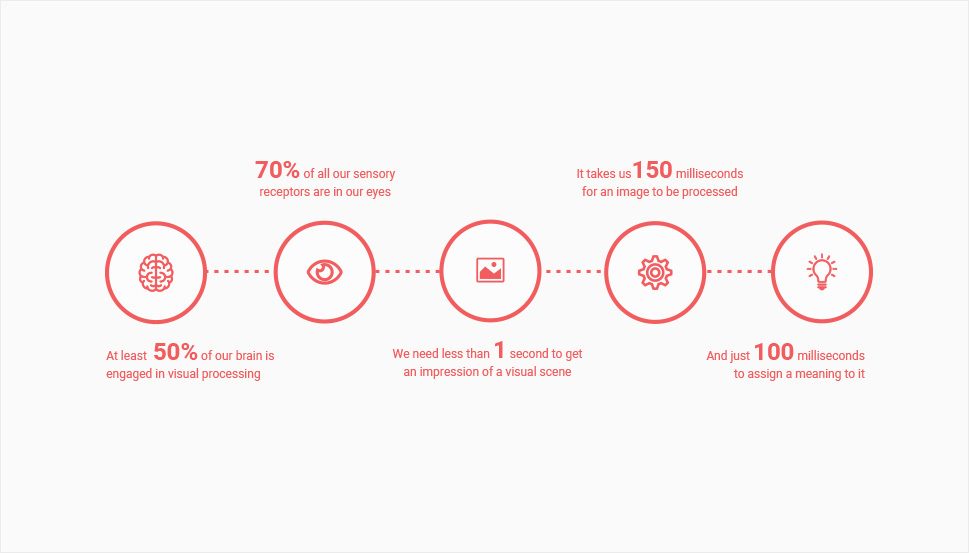How to Use Visual Storytelling to Double Your Ecommerce Sales

There have been many claims that the culture we live in today is predominantly visual, and it is often suggested that that’s not a particularly good thing. But the fact is that, as humans, we rely heavily on our sense of sight. Since we are born, we first learn to make sense of the world through what we see and touch, and it is only later that we learn to understand the language and name what we see. So, there is actually nothing unnatural or even bad about the fact that images affect us so deeply. They touch the oldest part of us that doesn’t need words to understand. That’s exactly why visual storytelling is such a powerful method used both for sales and marketing purposes.
Visual storytelling offers a unique opportunity for generating traffic and converting leads at every phase of the sales funnel. A good content marketing strategy should include it abundantly within its scope.
In this article, we’ll tap into the potential of using visual storytelling for increasing eCommerce sales, but before we do that, let’s make sure you understand what visual storytelling is.
Stay tuned to find out more about:

Visual storytelling uses images, graphs, gifs, and other visual media to tell the story in a more complete manner by providing an emotional background or by presenting very complex information through attractive visuals. It easily overcomes the language barrier and allows you to establish a connection with a very wide audience of different age groups, different ethnicities, and different professions.
Not only can you easily forge an emotional bond this way, but you can also share otherwise boring data like statistics in an interesting and appealing manner.
Any text will look more attractive if it is supported with matching images that highlight the most important facts, describe the motivation behind the text, or offer another view on the content in the text. As a company, if you tell your brand story using visual storytelling you’ll attract the right audience much faster than you’d do so without it.
In short, the benefits of using visual storytelling are many, and generally, it is a very effective strategy for the three following purposes:
-
Attracting and keeping the attention of your target audience
-
Supporting emotional connection between your audience and your brand
-
Creating effective messages that both resonate with and inform the audience
The style and aesthetics of the visuals you’ll use will depend on your goal, your brand identity, and your target audience but should be consistent with your brand values.

One of the many great things about visual storytelling is that it allows for a lot of creativity. You can choose from a wide array of media to use for this purpose and combine more than one type whenever you find it convenient. To help you get the picture of what you can do we’ll go through the eight most common types of visual storytelling media:
-
Photos
-
Custom Illustrations
-
Infographics
-
Charts and Graphs
-
Videos
-
Animations
-
Memes
-
GIFs
Photos
Photos, as you might have guessed, are commonly used in visual storytelling. They are great to convey either a literal or a symbolic message. You can use your own real-life photos from business events from your social media to depict the values of your brand for example or find premium images that perfectly describe the point of your article.
There are also many free resources of high-quality images that you can use for this purpose, just make sure, whatever the source of images you go for, that all the photos are of similar quality and aesthetics so that they fit your style.
Custom Illustrations

Catchy messages combined with alluring graphics have always been very effective in attracting attention. If you love the comic-like style that is especially convenient if you want to add a humoristic tone to your message, custom illustrations are an excellent choice but bear in mind that there are many different illustration styles you can use. When used for sales purposes, illustrations may not seem as convincing as photos, but they are often great at pointing out some abstract facts that are hard to represent visually. Illustrations without any text can also be used, and they are handy for highlighting certain facts or creating a specific type of atmosphere.
Infographics

Everybody loves to know about statistics but people are rarely interested in reading about it. Infographics are of immense help in that sense, as they help you present data in a visually appealing manner. Plus, numbers always look convincing, especially when you put them in the appropriate context.
Charts and Graphs

Just like infographics, charts and graphs help you display complex statistics in an easy-to-digest manner. They are also very useful in directing the user’s mind to a certain type of conclusion as they seem scientific and unbiased. Instead of explaining the facts in two paragraphs, a chart or a graph can highlight your point in just one image.
Videos

If you want to focus on demonstrating the value of your products/services, videos are a great choice. The somewhat surprising fact is that people tend to avoid listening to videos but only watch them, so it is smart to include key captions in the video and ensure they do not fail in delivering the target message. There are plenty of online tools for creating video material, you can also use your own videos from various business events, take a record of how the product looks like in real life, or create a video testimonial with a real consumer – the possibilities are many.
Animations

The beauty of animation lies in the fact that it can give life to your imagination. The only challenge with it is that you’ll probably need to hire a skillful designer to create a good animation. It is amazing what can come out from the software, brand guidelines, and designer’s talent. Animations can be successfully used for describing processes, instructions for product usage but also for creating fun content that adds distinct value to your brand.
Memes

Memes enjoy huge popularity on social media. Though they often don’t hold up to the premium aesthetic standards and don’t make much sense outside of the specific context, they are very sharable and amazing when it comes to achieving a wider reach. The point of a meme is to provoke a humorous reaction, and the aesthetics don’t play such an important role in this case. Before going with a meme, make sure it aligns with your communication style in general, or maybe select carefully the channels you’ll be using it on.
GIFs

GIFs are great for making your content more dynamic and engaging. They usually share a similar humorous tone like memes. They are playful, fun, and catchy. As such, they are used to incite a certain emotion, highlight a specific atmosphere and generally strengthen the user’s connection with the brand. They work great in email campaigns and on social media but you can use them anywhere you find convenient.
Context is Everything
While your images, illustrations, or videos may seem too simple or too common when consumed separately, in the right context they may seem very smart, witty, and charming. The quality of your visual material is of great importance, but it is the context that will ultimately decide how good your visuals actually are.
Focus on Your Point
It is easy to get seduced by the versatility of visual material you can use, but it is a true talent to be able to choose and combine the ones that subtly point in the same direction. It is not about stuffing your pages with attractive visual content, but about providing a unique framework and context for all the different visual materials you’ll use on your site. Only when they are synchronized and balanced can you tell your story the way you want to.
Stick to the Storyline
Conflict is what fuels every story, and there’s no exception for that in visual storytelling either. Walk your audience step by step towards the desired conclusion by following the universal storytelling rules: every story has a beginning, a conflict, or an obstacle (which could be the problem you’re solving for your customers) and a conclusion which in sales is a CTA.
Show Instead of Telling
Your visuals should be self-explanatory. If they can hardly be understood without some textual explanation, you might want to reconsider if you made the best choice of your visual media. The readers will not bother to decipher visuals with too many details while a simple yet strong visual metaphor will linger in their thoughts for days.
Follow the Visual Hierarchy
This means that you should place the biggest, the most effective, and the most important visual first, and create a natural flow for all the other visual materials you were planning to use.
Stay True to Your Brand
Make sure you use all the same fonts, colors, and styles on your visuals. This will help you strengthen your brand image, and it will allow you to use very different visuals in the same context without jeopardizing the overall aesthetics and design of your website.
Humans like Humans in Pictures
Including people or human figures in your visuals will make your message seem a lot more trustworthy. People tend to relate to other people so you should provide them the opportunity to do that in your visuals too.
Know Your Audience
You need to adjust the media to your target audience, to the platform you are using, and to the phase of the customer journey you want to address. It is recommended to use images for cold prospects whereas videos are most effective for retargeting campaigns. Generally, if the majority of your conclusions about your audience acquired via different analytics tools all point that your users prefer and react better to a certain type of media, make sure to use it abundantly. Bear in mind that knowing your target audience is essential in every step.
Wrapping it All Up
You can find plenty of stats that prove how human beings are visually wired, but maybe the best way to understand how much this fact affects us on an everyday level is to close your eyes and try to remember anything from this article. We can bet the first thing that will show up in your mind will be some of the images from the text and not the plain text itself.
Without implementing visual storytelling into your content marketing strategy, you can easily lose a large share of your audience. And bearing in mind how much creativity comes with it, it is not only useful but also very inspiring to tell your story using visual storytelling methods.



